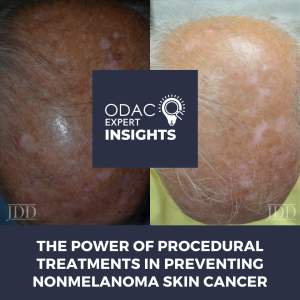
July is UV Awareness Month. At the 2025 ODAC Dermatology Conference, C. William Hanke, MD, presented on preventing nonmelanoma skin cancer (NMSC) through the power of procedural treatments. In this session, Dr. Hanke outlined cosmetic and therapeutic interventions that offer both aesthetic improvement and a reduced risk of skin cancer.
Before detailing the interventions, Dr. Hanke pointed out that cosmetic treatments that cause controlled injury to the skin have been found to increase IGF-1 levels in fibroblasts. IGF-1 is a growth factor critical for suppressing UV-damaged keratinocytes.
For aging patients who have extensive actinic damage, Dr. Hanke recommends the aggressive use of photodynamic therapy (PDT), chemical peels, dermabrasion, and topical chemotherapy agents. Dr. Hanke says these treatments not only improve the cosmetic appearance of the skin but also decrease NMSC risk.
Key points from the session include:
- Dr. Hanke has found that frequent utilization of PDT significantly reduces the annual incidence of NMSC in his patients. While the therapy can be significantly uncomfortable, Dr. Hanke says ALA incubation time, wavelength, and distance to light source can be modified to make the procedure more tolerable. In addition, cold air anesthesia can alleviate discomfort.
- Dr. Hanke cited a 2023 study showing that non-ablative fractional laser treatment is associated with a decreased risk of subsequent facial keratinocyte carcinoma development by 20.9% in treated patients compared to 40.4% in the control group.
- Dr. Hanke cautioned against the general use of aggressive lasers on the chest, such as the erbium laser, or CO2 laser, due to the risk of scarring and hypopigmentation.
- A notable 2006 randomized controlled trial compared the efficacy of 5-FU, CO2 laser, and 30% TCA peel in reducing actinic keratoses (AKs). The results showed an 83-92% reduction in AKs in the experimental groups compared to control, with the TCA group exhibiting the lowest rate of NMSC.
- Dr. Hanke frequently uses dermabrasion with a nerve block for patients with extensive actinic damage and a history of NMSC on the nose.
Dr. Hanke emphasized the dual role of procedural dermatology in both cosmetic rejuvenation and cancer prevention. By integrating therapies, such as PDT, lasers, chemical peels, and dermabrasion, dermatologists can tailor treatments to significantly reduce NMSC risk while improving skin quality.
This session summary was written by Vixey Silva, DO and published on Next Steps in Derm.
Register for ODAC 2026 for more updates on preventing skin cancer.
